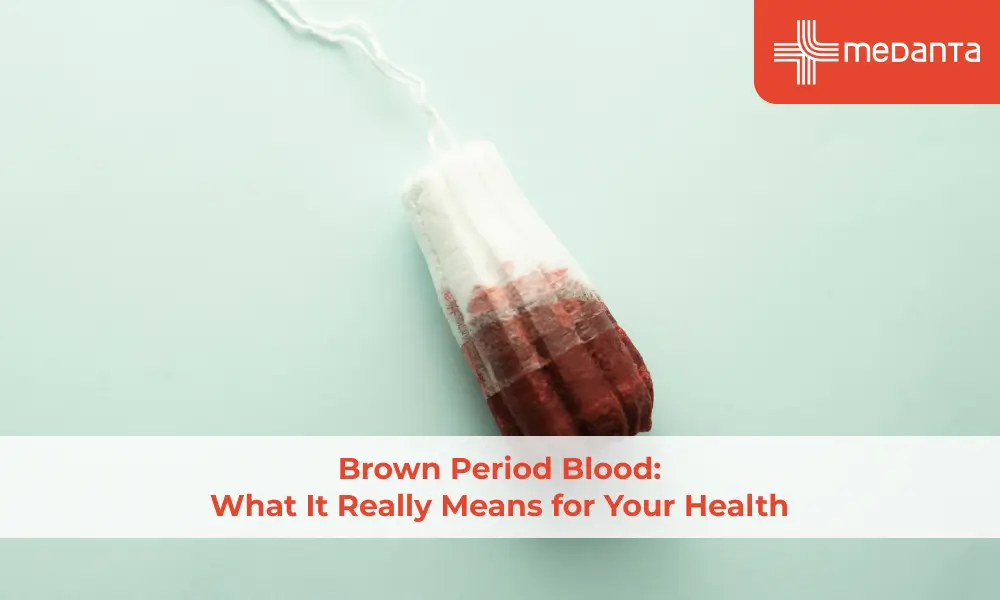Brown Period Blood: What It Really Means for Your Health

TABLE OF CONTENTS
Brown period blood affects most women at some point in their lives, typically appearing at the beginning or end of menstruation. This common variation is usually nothing to worry about, as it simply indicates older blood that has had time to oxidise while moving more slowly through the body. The shade & consistency of menstrual blood provides valuable insights into a woman's health status.
This guide explores what brown period blood means, when it typically occurs, and when it might signal a need to consult a doctor. Understanding these variations can help women better interpret their menstrual health and know when to seek professional advice.
What Causes Brown Period Blood? Is it Normal?
The brown colour in period blood primarily results from a natural process called oxidation. This occurs when blood takes longer to exit the body, giving it more time to be exposed to oxygen, transforming it from bright red to brown. Consequently, brown menstrual blood is completely normal and indicates older blood.
Brown period blood typically appears at specific times during the menstrual cycle -at the beginning of your period, which might be leftover blood from the previous cycle.
Certain medical conditions may present with brown discharge as a symptom, including yeast infections, sexually transmitted infections, inflammatory conditions like cervicitis or vaginitis, and rarely, cervical cancer. Therefore, while brown period blood is generally harmless, accompanying symptoms should not be ignored.
When Does Brown Blood Typically Occur?
Brown period blood appears at specific, predictable times throughout a woman's reproductive journey. Understanding these patterns helps women identify what is normal and what might need medical attention.
The beginning and end of menstruation often feature brown blood because the flow moves more slowly during these times. When blood exits the body quickly, it maintains its red colour, but slower movement allows time for oxidation, turning it brown. Many women notice this darker shade specifically as their period tapers off.
Mid-cycle spotting presents another common occurrence of brown discharge. This happens during ovulation for some women, particularly those just starting their periods. Additionally, spotting in the middle of the menstrual cycle frequently links to the egg-release phase and may come with other signs:
Low abdominal pain
Discharge with egg-white consistency
Basal body temperature changes
For pregnant women, brown discharge might indicate implantation bleeding, occurring approximately 10 to 14 days after conception. This spotting happens when the fertilised egg attaches to the uterine lining.
Following childbirth, women experience lochia, or postpartum discharge, which can last up to six weeks. Initially, this appears as a heavy red flow but gradually changes to brown around the fourth day as the bleeding slows down.
Brown discharge becomes increasingly common throughout perimenopause. Fluctuating oestrogen levels affect the uterine lining, leading to irregular periods with varying colours and textures. Brown blood frequently replaces normal periods during this transitional phase.
Females with polycystic ovary syndrome (PCOS) often experience brown discharge between cycles. This happens because PCOS can prevent proper ovulation, causing the uterine lining to build up but not shed correctly. The result is irregular periods with more than 35 days between cycles and occasional brown spotting.
Brown discharge may likewise appear after an abortion as the body heals. In most cases, this gradual fading from red to brown discharge represents a normal healing process rather than a complication.

Possible Health Implications of Brown Period Blood
While most cases of brown period blood are harmless, this colour variation can sometimes indicate underlying health conditions that require attention.
Pregnancy-related condition: Brown spotting during early pregnancy often indicates implantation bleeding, occurring when a fertilised egg attaches to the uterine lining. However, any bleeding during pregnancy warrants medical assessment as it might signal complications like a missed miscarriage. In this situation, the pregnancy stops developing, but tissue doesn't pass out of the uterus for at least 4 weeks, resulting in dark brown spotting instead of heavy bleeding.
Polycystic ovary syndrome: Polycystic ovary syndrome (PCOS) frequently causes brown discharge as a symptom. When PCOS prevents proper ovulation, the uterine lining builds up but doesn't shed normally, creating light or missed periods with brown blood between cycles.
Infections or inflammatory conditions: Sexually transmitted infections (STIs) like gonorrhoea or chlamydia may present with brown spotting alongside other symptoms.
Inflammatory conditions such as cervicitis or vaginitis can also cause brown discharge, typically accompanied by a strong smell, pelvic pain, discomfort during intercourse, or pain when urinating.
Perimenopause: Women experiencing perimenopause commonly notice brown discharge due to fluctuating oestrogen levels. These hormonal changes affect the uterine lining, causing irregular shedding and oxidised blood. Accordingly, this is considered normal during this life stage unless accompanied by other concerning symptoms.
When to See a Doctor About Brown Period Blood
Despite being common, certain patterns of brown period blood require prompt medical assessment.
Women should seek medical advice if:
Brown discharge persists for several weeks without developing into a normal period
Brown discharge appears with abnormal symptoms like severe cramping, pain, itching, or a foul odour
Prolonged periods lasting more than seven days
Bleeding between periods or after sexual intercourse
Any bleeding after menopause
Brown discharge with lower abdominal pain, fever, or unusual fatigue
Heavier than normal flow that soaks through pads or tampons quickly
For pregnant women, even light brown spotting requires immediate medical attention. Certainly, any bleeding during pregnancy could indicate potential complications. This becomes particularly urgent if accompanied by cramping, pain, vaginal discharge, or dizziness—possible signs of miscarriage or ectopic pregnancy.
Women with brown discharge who also experience symptoms suggesting fibroids should consult a doctor immediately. These symptoms include heavy periods lasting over seven days, anaemia leading to fatigue, pain during intercourse, frequent urination, constipation, bloating, pelvic or lower back pain, and increased menstrual cramping.
Brown discharge, alongside other symptoms, might indicate PCOS, primarily if accompanied by irregular cycles, abnormal hair growth, obesity, acne, or thickened skin patches. Unfortunately, unusual spotting between menstrual cycles might also signal sexually transmitted infections such as chlamydia or gonorrhoea.
As such, regardless of how minor brown discharge might seem, any significant change from your normal period pattern deserves professional attention. Early intervention often leads to better outcomes for any underlying conditions.
Conclusion
Brown period blood certainly appears alarming at first, but most women experience it at some point in their lives. This colour variation typically signals older blood that has had time to oxidise rather than a cause for concern. The timing of brown discharge—whether at the beginning or end of menstruation, during ovulation, or in perimenopause—usually follows predictable patterns that align with normal bodily processes.
However, women should pay attention to any unusual changes in their menstrual cycles. While brown blood by itself rarely indicates a problem, persistent discolouration accompanied by symptoms like severe pain, foul odours, or irregular bleeding patterns might signal underlying health conditions such as PCOS, infections, or pregnancy complications. These situations require prompt medical assessment.
Understanding your body's normal patterns helps you recognise when something has changed. Therefore, tracking your cycle, including the colour and consistency of your period blood, gives you valuable information about your reproductive health. This knowledge enables people to make better and more informed decisions about when to seek gynaecologist consultation.
FAQs
Is brown period blood normal?
Brown period blood is generally normal and common. It typically occurs at the beginning or end of menstruation, indicating older blood that has had time to oxidise. However, if it persists for several weeks or is accompanied by unusual symptoms, it's advisable to consult a doctor.
What causes brown period blood?
Brown period blood is due to the blood oxidation as it moves slowly through the body. This can happen at various times during the menstrual cycle, including the start or end of a period, during ovulation, or when using hormonal birth control. Hormonal changes, such as those during perimenopause, can also lead to brown discharge.
When should I be concerned about brown period blood?
While brown period blood is often normal, you should seek medical advice if it persists for several weeks without developing into a normal period or if it is accompanied by severe cramping, pain, itching, or a foul odour. Any bleeding during pregnancy or after menopause also warrants immediate medical attention.
Can brown period blood indicate pregnancy?
Yes, brown spotting can sometimes indicate implantation bleeding, which is an early sign of pregnancy. This typically occurs about ten to fourteen days after conception. However, any bleeding during pregnancy should be reported to a doctor as it might indicate other conditions.
How does brown period blood relate to hormonal conditions?
Brown period blood can be associated with hormonal conditions such as polycystic ovary syndrome (PCOS). In PCOS, irregular ovulation can lead to the build-up of the uterine lining, resulting in light or missed periods with brown discharge between cycles. Perimenopause can also cause brown discharge due to fluctuating oestrogen levels affecting the uterine lining.






